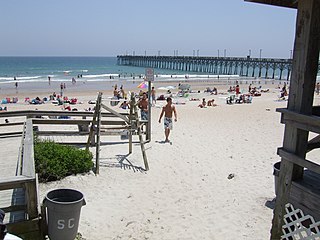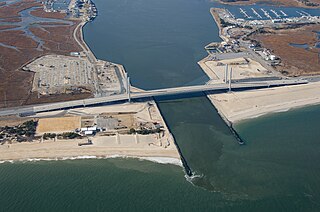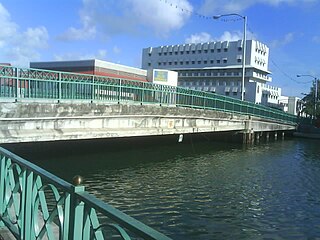
Bridgetown is the capital and largest city of Barbados. Formerly The Town of Saint Michael, the Greater Bridgetown area is located within the parish of Saint Michael. Bridgetown is sometimes locally referred to as "The City", but the most common reference is simply "Town". As of 2014, its metropolitan population stands at roughly 110,000.

Surf City is a town in Pender and Onslow counties in the U.S. state of North Carolina. The population was at 1,853 at the 2010 census. It is located on Topsail Island.

The Indian River is a river and estuary, approximately 15 mi (24 km) long, in Sussex County in southern Delaware in the United States. The river is named after a Native American reservation that was located on its upper reaches.
Charles Duncan O'Neal was a Barbados physician, political figure and labor rights activist. He founded the radical Democratic League in 1924 and influenced the shift towards party-focused politics still seen in Barbados today.

Bridgetown is a Canadian community located in north-central Annapolis County, Nova Scotia.

The Spuyten Duyvil Bridge is a railroad swing bridge that spans the Spuyten Duyvil Creek between Manhattan and the Bronx, in New York City. The bridge is located at the northern tip of Manhattan where the Spuyten Duyvil Creek meets the Hudson River, approximately 1,000 feet (300 m) to the west of the Henry Hudson Bridge.

The North Avenue Bridge can refer to one of three bridges that has carried North Avenue over the North Branch of the Chicago River on the north side of Chicago, Illinois. A center-pier swing bridge built in 1877 was replaced in 1907 by a bascule bridge, allowing river traffic more room for maneuvering in and out of the North Canal, just north of Goose Island.

The Fourteenth Street Bridge, also known as the Ohio Falls Bridge, Pennsylvania Railroad Bridge, Conrail Railroad Bridge or Louisville and Indiana (L&I) Bridge, is a truss drawbridge that spans the Ohio River, between Louisville, Kentucky and Clarksville, Indiana.

The Cochrane–Africatown USA Bridge is a cable-stayed bridge carrying US 90/US 98 Truck across the Mobile River from the mainland to Blakeley Island in Mobile, Alabama.

Delaware Route 14 (DE 14) is a state highway in the southern part of Kent County, Delaware. The route runs from the Maryland border near Burrsville, Maryland, where the road continues as Maryland Route 317 (MD 317), east to DE 1 in Milford. The route passes through Harrington, where it intersects U.S. Route 13 (US 13), and passes to the north of Houston before coming to Milford, where it intersects DE 15, US 113, and DE 1 Business. DE 14 has a truck bypass of Harrington known as DE 14 Truck.

The A19 Tees Viaduct or Tees Flyover is a high level six-lane dual carriageway road bridge in the North East of England carrying the main A19 trunk road north–south across the River Tees.
Lawrence C. Bank is the associate provost for research at The City College of New York and a professor in the Department of Civil Engineering at the Grove School of Engineering. He is a registered Professional Engineer in the State of Wisconsin and the District of Columbia. He is a Fellow of the American Society of Civil Engineers, as well as a Fellow and currently President of the International Institute for FRP Composites in Construction. Prior to joining CCNY, Bank was on the faculty of the University of Wisconsin–Madison, the Catholic University of America and Rensselaer Polytechnic Institute. He has worked as a structural engineer for Leslie E. Robertson and Associates in New York City and as a consultant for the composite materials industry.

The Norwalk River Railroad Bridge is a swing bridge built in 1896 for the New York, New Haven and Hartford Railroad. It currently carries Amtrak and Metro-North Railroad trains over the Norwalk River.
John Hillman, P.E. is an American structural engineer who invented the hybrid composite beam (HCB) and founded the HC Bridge Company. In 2010, he was recognized with the Award of Excellence from Engineering News-Record.

Charles Duncan O'Neal Bridge is a bridge in Bridgetown, Barbados. It is one of two bridges over the Careenage, the other being the Chamberlain Bridge, although unlike the Charles Duncan Bridge it does not take traffic. It is named after Charles Duncan O'Neal who founded the radical Democratic League in 1924.

The Great Eddy Covered Bridge, also called the Big Eddy Covered Bridge or Waitsfield Covered Bridge, is a wooden covered bridge that crosses the Mad River in Waitsfield, Vermont on Bridge Street. Built in 1833, it is one of Vermont's oldest covered bridges. It was listed on the National Register of Historic Places in 1974.

The 12th Pan American Junior Athletics Championships were held in Bridgetown, Barbados at the National Stadium on 18–20 July 2003. Jamaican sprinter Usain Bolt had the outstanding performance equalling the 200m World Junior record, while the team of the USA dominated the championships gaining 48 medals.

The Cherry Street lift bridge over the Keating Channel is the smaller of two bascule lift bridges on Cherry Street, in Toronto, Ontario, Canada. The bridge spans the canalized mouth of the Don River where it empties into Toronto Harbour. It is the fourth bridge at that location.

The Indian River Inlet Bridge is a cable-stayed bridge located in Sussex County, Delaware, in the United States. It carries four lanes of Delaware Route 1 over the Indian River Inlet between the Indian River Bay and the Atlantic Ocean. The bridge also carries Delaware Bicycle Route 1 across the inlet. The bridge is within Delaware Seashore State Park between Dewey Beach and Bethany Beach. The Indian River Inlet Bridge is maintained by the Delaware Department of Transportation (DelDOT). The bridge is 2,600 feet (790 m) long and 107.66 feet (32.81 m) wide, with a span of 950 feet (290 m) and overhead clearance of 45 feet (14 m).
Little Mehoopany Creek is a tributary of the Susquehanna River in Wyoming County, Pennsylvania, in the United States. It is approximately 8.4 miles (13.5 km) long and flows through Windham Township and Mehoopany Township. The watershed of the creek has an area of 11.3 square miles (29 km2), most of which is forested land and agricultural land. No stream in the watershed is designated as an impaired waterbody. The main rock formation in the watershed is the Catskill Formation and the main soil association is the Wellsboro-Oquaga-Morris.





















